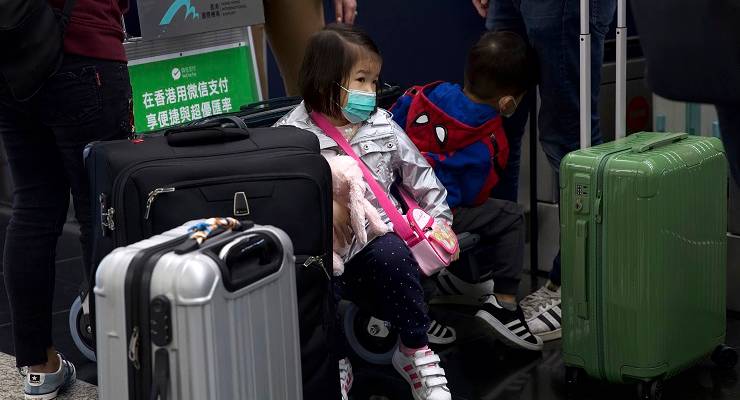
Nature — and its ability to attack mankind — has shown exquisite timing with the spread of the latest coronavirus. Just days ahead of the Chinese New Year Festival — which triggers the world’s largest annual human migration — China and much of the Asia-Pacific region is gripped by panic.
The epicentre of the potentially deadly respiratory infection pandemic, known as 2019-nCoV, appears to be the central Chinese metropolis of Wuhan (population 11 million) where it was first detected in humans in December.
So far, about 300 cases have been reported in Beijing, Shanghai and the southern province of Guangdong, which neighbours Hong Kong, thousands of kilometres away from Wuhan. This number has jumped by almost 50% in two days. There are suspected cases in 13 other provinces.
The University of Hong Kong estimates the virus has already spread to 20 other Chinese mainland cities. In Hong Kong, 12 new suspected infections were reported in the 24 hours to midday Tuesday.
The virus has already slipped China’s borders, with cases in South Korea, Japan, Taiwan and Thailand — where a British man is fighting for his life after reportedly contracting the disease on the holiday island Koh Phi Phi.
Six people, all with pre-existing ailments and over 48 years old, have died so far.
A man in Brisbane who recently returned from Wuhan — the city has three direct flights to Australia each day — is in quarantine waiting for test results.
Medical experts are concerned that the dramatic geographic spread of the virus means that considerably more people may be infected. Researchers are also concerned because China has initially been slow the provide information to the WHO.
Then there are the risks associated with the Chinese New Year.
Hundreds of millions of people traverse China to be with their families during this time. In 2018, almost 7 million Chinese tourists travelled abroad for what is also known as the Spring Festival, according to state media. A perfect viral storm.
Front of mind, especially for China’s ruling Communist Party, is the tragic initial cover-up and under-reporting of SARS (severe acute respiratory syndrome), which doctors have described as a “cousin” of this coronavirus.
An outbreak of SARS, originating in China and lasting from late 2002 to mid-2003, saw 8098 people infected. It resulted in 774 deaths in 37 countries, according to the World Health Organisation. Hundreds of these deaths were sheeted home to the panicked and misguided cover-up by Chinese authorities.
Zhong Nanshan — the specialist who identified SARS and who leads a team of experts at the China National Health Commission — said this week: “The outbreak is at a critical stage and we estimate an increasing number of infections during the 40 days of the Spring Festival travel rush.”
On January 20, China’s National Health Commission confirmed the virus can be transmitted from human to human, and that 15 medical staff who treated the first patients in Wuhan have also been infected.
Warnings on Wuhan local radio on January 21 reported that 95% of the cases were connected with Wuhan and that the strategy is prevention and isolation. State media said China has a good response system now and this incident won’t be comparable to the SARS incident of 15 years ago.
The hyperbolic language of a message issued by an official social media account of the Communist Party’s Central Political and Legal Affairs Commission left no doubt as to how determined Beijing is to revisit that scandal: “Anyone who deliberately delays and hides the reporting of [virus] cases out of his or her own self-interest will be nailed on the pillar of shame for eternity.”
Yet there are already reports of hospitals not testing people and pushing for quick cremations for people who have died from “pneumonia”.
In an effort to stem panic, at least eight people spreading “rumours” on social media in Wuhan have been detained (in China, only “official” information is certifiably legal). The Wuhan municipal party committee has forbidden any officials from leaving the city.
The obvious question is, if this is indeed a killer virus, how do we limit infections? Is China — and Australia, for that matter — sufficiently prepared to stop it spreading?








What has happened to Australia’s quarantine policies for infectious diseases that has protected this continent in the past? – Is the tourism dollar more important than protection of the Australian population?
If you don’t want to get infected:
– Live in remote country locations
– Only eat local food
– Don’t go to hospital unless you must
– Don’t travel any further than you must
– Don’t go to Asia.
To be fair Dinkins about this, we would have had to cancel all flights from Wigan initially, then China, then every other country where the virus was found. We don’t have that sort of courage, very few do, perhaps none. Trade, international travel, or in other words money always gets in the way.
This one may not be that bad, overall, but we are way overdue a seriously deadly pandemic.
Fair Dinkins!!!!!! Really!!! In what world does fair dinkum become that?